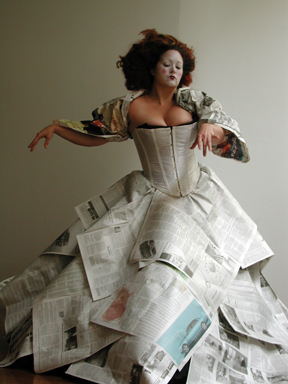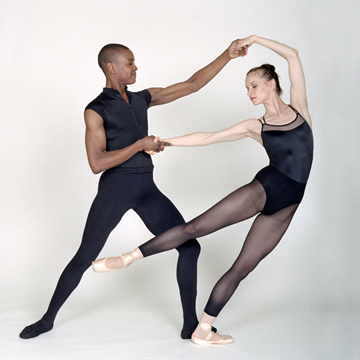"ignored in my heaven"
Glen Rumsey Dance Project
Location One
New York, NY
September 16, 2005
Bach Trilogy
New Chamber Ballet
City Center Studios
New York, NY
September 17, 2005
by Leigh Witchel
copyright ©2005 by Leigh Witchel
.jpg) Location, location, location. It's as important in dance as in real estate. Renting a conventional theater can be more than an independent dance company can afford; rent the wrong one and people won’t even go. Dance in alternative spaces, such as studios and galleries, is a way of life in New York.
Location, location, location. It's as important in dance as in real estate. Renting a conventional theater can be more than an independent dance company can afford; rent the wrong one and people won’t even go. Dance in alternative spaces, such as studios and galleries, is a way of life in New York.
Claire Montgomery, the founder of Location One, is an angel for enthusiastically supporting new work like Glen Rumsey’s “ignored in my heaven”, but there’s no denying Location One, which functions mainly as a gallery, is a difficult space for dance. It's crowded and uncomfortable with cramped folding chairs and bleachers. Two poles stand sentinel in the front, blocking what portion of your view the head of the person in front of you hasn't already obscured. Plastic sheets like overgrown shower curtains were hung from the poles as scenery, forcing the audience to shrink away or duck through them to get to their seats. The atmosphere—ntimate, close and shrouded—was like a jamboree at a sex club.
To create "ignored in my heaven", Rumsey drew inspiration from journals he kept of his dreams. It showed; the work was deliberately as unstructured and episodic as a dream. Dancers drifted through the space in fantastical costumes. Speckled projections on every wall (created by Marisela La Grave) contributed, along with the plastic curtains, to the blurry otherworldliness. The music was a collage of popular and classical music, sometimes familiar and sometimes distorted covers of the familiar.
The mix of aesthetics and references in the piece, from Merce Cunningham to “Charlie’s Angels”, seemed wildly divergent but it was no more divergent than Rumsey’s experience as a dancer with the Cunningham company and his parallel life as a fierce and much loved drag queen, Miss Shasta Cola. He has lived in many worlds and many talented friends from them joined in to help out.
Cheryl Therrien, Banu Ogan (both former Cunningham dancers) and A. Apostol entered wearing turbans made out of bubble wrap, gowns with red bustles and trains made of plastic sheeting. The bustles turned out to be people— Katherine Nauman, Jean Freebury, Ede Thurell—who were deposited to form another trio.
 All the costumes were silk and trash. Linda Martini was wheeled in on a couch in a tour de force bodiced gown made of newspapers. The designs are excessive and witty—if it sounds like I loved them, I should. David Quinn, who created them in conjunction with Rumsey, was also the costumer for most of my concerts. The entire performance was conceived visually; the costumes and décor carried the evening more than the choreography or narrative.
All the costumes were silk and trash. Linda Martini was wheeled in on a couch in a tour de force bodiced gown made of newspapers. The designs are excessive and witty—if it sounds like I loved them, I should. David Quinn, who created them in conjunction with Rumsey, was also the costumer for most of my concerts. The entire performance was conceived visually; the costumes and décor carried the evening more than the choreography or narrative.
Befitting any diva, we saw Shasta Cola before we saw Rumsey and she got a late entrance once the dance was underway. Shasta came out in full fabulousness with a leashed human “dog” on all fours in what could have been a typical drag act (in fact, I think they did this a few weeks back at Robert Melee’s “The Talent Show”), but one that went awry. A man came over and ripped off Shasta’s outfit one piece at a time including the wig until Rumsey was left in red skivvies. Though I accepted it, it's a cliché that won’t work for everyone.
A dance that was not a cliché set the dancers in costumes of ghostly white balloons held to their bodies by loose netting. The distortion of the body by the balloons reminded me of Rei Kawakubo's stuffed and padded costumes for Cunningham’s "Scenario." The evening finished with a slam-bang unison number similar to those by another choreographer that Rumsey has worked with, Stanley Love.
A dream is intensely personal, and seeing someone else’s dream is something you either identify with or don’t. I’m too close to Rumsey’s world (I have worked with or am friendly with the majority of the cast) not to respond to it. I first became familiar with Merce Cunningham’s work in the mid-90’s when Rumsey was in the company and for me, one of the greatest pleasures of the performance was the nostalgically sweet one of seeing those dancers— Ogan, Therrien and Freebury—again.
Miro Magloire’s New Chamber Ballet takes an approach to studio dance performances opposite to Rumsey’s. New Chamber Ballet is a barebones operation rigorously pared down to the essentials. Small casts, simple leotard costumes and no lighting beyond a dimmer are all part of an ascetic approach. But there’s also glorious live music, Bach played so beautifully on violin and piano by Melody Fader and Erik Carlson that it could make the most uncomfortable folding chair bearable.
 Magloire’s approach to ballet can be as intellectual and ascetic as well. The studio contributes to the atmosphere. In their presentational and frontal character the dances don’t seem built for a room, but rather for an imaginary proscenium theater. At New Chamber Ballet performances you’re as aware of what isn’t there (lights, proscenium) as what is. It forces attention on what’s left—the dance and the dancers—sometimes mercilessly.
Magloire’s approach to ballet can be as intellectual and ascetic as well. The studio contributes to the atmosphere. In their presentational and frontal character the dances don’t seem built for a room, but rather for an imaginary proscenium theater. At New Chamber Ballet performances you’re as aware of what isn’t there (lights, proscenium) as what is. It forces attention on what’s left—the dance and the dancers—sometimes mercilessly.
Along with an unrelated solo by guest artist Megumi Eda, three Bach pieces were presented by Magloire: “Dawn”, “Preludes” and “Fall”. All three were trios, “Dawn” and “Preludes” all female and “Fall” using a man. The austere pieces shared some motifs, such as having the dancers lay on the floor in rest or rise from it while on pointe. “Preludes” seemed the most successful and grateful to the dancers. Each dancer (Christin Hanna, Denise Small and Julia Welsh) performed a solo and then a finale together. Each solo was demanding in a different way but it’s a hallmark of Magloire’s work to require extremely articulate footwork. Small delivered that particularly and Welsh has a knack for filling in non-dance moments as well as the dance ones. The finale contained a difficult but handsome set of turns that looked particularly smooth on Welsh and Hanna, and then all three suddenly broke into a phrase of battement developpés that really moved. It would be welcome to see more kinetic moments such as those in the ballets. As presentational as the dances are, they are also so formal that we seem invited to watch them but not participate emotionally or viscerally. Magloire keeps refining his process through diligent work. Now he needs to include the audience in it.
Both Rumsey and Magloire took different approaches to their surroundings and both could develop this in further projects. The New Chamber Ballets is a unique and canny effort. By restricting the company and performing in simple surroundings, Magloire can afford to do five performances over the year. That’s a season, and that’s impressive. He lives up to the “Ballet” part of his name as well; there’s no question of his commitment to the classical idiom. It would be interesting to see him fully explore the “Chamber,” too. Perhaps choreographing for the room as it is, with the possibility of spectators anywhere, instead of a nonexistent proscenium theater?
Rumsey’s work also seems to want to break the fourth wall. He chose to emphasize it instead with plastic sheeting, but there was something about the dreamlike quality of the work that seemed to want its spectators to pass through it instead of view it from a fixed point.
Volume 3, No. 34
September 19, 2005
copyright
©2005 Leigh Witchel
www.danceviewtimes.com
|
|